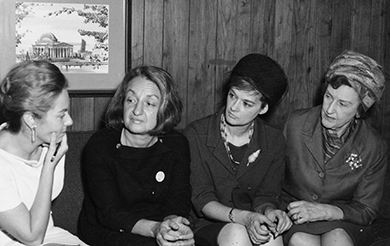| << Chapter < Page | Chapter >> Page > |
On the national scene, the civil rights movement was creating a climate of protest and claiming rights and new roles in society for people of color. Women played significant roles in organizations fighting for civil rights like SNCC and SDS. However, they often found that those organizations, enlightened as they might be about racial issues or the war in Vietnam, could still be influenced by patriarchal ideas of male superiority. Two members of SNCC, Casey Hayden and Mary King, presented some of their concerns about their organization’s treatment of women in a document entitled “On the Position of Women in SNCC.” Stokely Carmichael responded that the appropriate position for women in SNCC was “prone.”
Just as the abolitionist movement made nineteenth-century women more aware of their lack of power and encouraged them to form the first women’s rights movement, the protest movements of the 1960s inspired many white and middle-class women to create their own organized movement for greater rights. Not all were young women engaged in social protest. Many were older, married women who found the traditional roles of housewife and mother unfulfilling. In 1963, writer and feminist Betty Friedan published The Feminine Mystique in which she contested the post-World War II belief that it was women’s destiny to marry and bear children. Friedan’s book was a best-seller and began to raise the consciousness of many women who agreed that homemaking in the suburbs sapped them of their individualism and left them unsatisfied.
The Civil Rights Act of 1964, which prohibited discrimination in employment on the basis of race, color, national origin, and religion, also prohibited, in Title VII , discrimination on the basis of sex. Ironically, protection for women had been included at the suggestion of a Virginia congressman in an attempt to prevent the act’s passage; his reasoning seemed to be that, while a white man might accept that African Americans needed and deserved protection from discrimination, the idea that women deserved equality with men would be far too radical for any of his male colleagues to contemplate. Nevertheless, the act passed, although the struggle to achieve equal pay for equal work continues today.
Medical science also contributed a tool to assist women in their liberation. In 1960, the U.S. Food and Drug Administration approved the birth control pill, freeing women from the restrictions of pregnancy and childbearing. Women who were able to limit, delay, and prevent reproduction were freer to work, attend college, and delay marriage. Within five years of the pill’s approval, some six million women were using it.
The pill was the first medicine ever intended to be taken by people who were not sick. Even conservatives saw it as a possible means of making marriages stronger by removing the fear of an unwanted pregnancy and improving the health of women. Its opponents, however, argued that it would promote sexual promiscuity, undermine the institutions of marriage and the family, and destroy the moral code of the nation. By the early 1960s, thirty states had made it a criminal offense to sell contraceptive devices.
In 1966, the National Organization for Women (NOW) formed and proceeded to set an agenda for the feminist movement ( [link] ). Framed by a statement of purpose written by Friedan, the agenda began by proclaiming NOW’s goal to make possible women’s participation in all aspects of American life and to gain for them all the rights enjoyed by men. Among the specific goals was the passage of the Equal Rights Amendment (yet to be adopted).

More radical feminists, like their colleagues in other movements, were dissatisfied with merely redressing economic issues and devised their own brand of consciousness-raising events and symbolic attacks on women’s oppression. The most famous of these was an event staged in September 1968 by New York Radical Women. Protesting stereotypical notions of femininity and rejecting traditional gender expectations, the group demonstrated at the Miss America Pageant in Atlantic City, New Jersey, to bring attention to the contest’s—and society’s—exploitation of women. The protestors crowned a sheep Miss America and then tossed instruments of women’s oppression, including high-heeled shoes, curlers, girdles, and bras, into a “freedom trash can.” News accounts famously, and incorrectly, described the protest as a “bra burning.”
During the 1960s, many people rejected traditional roles and expectations. Influenced and inspired by the civil rights movement, college students of the baby boomer generation and women of all ages began to fight to secure a stronger role in American society. As members of groups like SDS and NOW asserted their rights and strove for equality for themselves and others, they upended many accepted norms and set groundbreaking social and legal changes in motion. Many of their successes continue to be felt today, while other goals remain unfulfilled.

Notification Switch
Would you like to follow the 'U.s. history' conversation and receive update notifications?